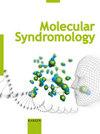A Male Child with Infantile Epilepsy due to a Mosaic Missense Variant of PCDH19
IF 0.9
4区 医学
Q4 GENETICS & HEREDITY
引用次数: 0
Abstract
Background: Pathogenic variants of PCDH19, located on the X-chromosome (Xq22.1), cause a rare epileptic encephalopathy with speech and development delay, seizures, behavioral and psychiatric problems. The specific underlying pathogenic mechanism is known as “cellular interference” that results in affected heterozygous females, normal hemizygous males and affected mosaic males but its functioning is not yet clear. Objectives: Reporting new cases of affected males is considered useful to a deeper insight. Subject and Method: We present the case of a three-year-old boy with early-onset seizures at 3 months of age, mild cognitive impairment, partial control of seizures with levetiracetam, normal brain imaging. Results: The patient has a mosaic pathogenic variant c.698A>G (p.Asp233Gly) in PCDH19 assessed by Next Generation Sequencing analysis. We have compared his characteristics with the genotypes and phenotypes of 34 PCDH19 mosaic males earlier reported in the literature. Finally, we have summarized today’s knowledge about phenotype-genotype correlation and pharmacological response in these patients. Conclusions: Our report confirms that the clinical picture of mosaic affected males, resembling that of females, can show a wide variability in severity of disease and underlines a stringent need to improve therapeutic approaches and to collect data on long-term follow-up.一名因 PCDH19 马赛克错义变异而患有婴儿癫痫的男童
背景:位于x染色体(Xq22.1)的PCDH19致病性变异可导致一种罕见的癫痫性脑病,伴有语言和发育迟缓、癫痫发作、行为和精神问题。具体的潜在致病机制被称为“细胞干扰”,导致受影响的杂合子雌性,正常半合子雄性和受影响的马赛克雄性,但其功能尚不清楚。目的:报告受影响男性的新病例被认为有助于更深入的了解。对象和方法:我们报告一名三岁男孩,在3个月大时出现早发性癫痫发作,轻度认知障碍,左乙拉西坦部分控制癫痫发作,脑成像正常。结果:经Next Generation Sequencing分析,患者PCDH19存在一个花叶致病变异c.698A>G (p.Asp233Gly)。我们将其特征与文献报道的34个PCDH19花叶雄性的基因型和表型进行了比较。最后,我们总结了目前关于这些患者的表型-基因型相关性和药理学反应的知识。结论:我们的报告证实,受花叶病影响的男性的临床表现与女性相似,可以显示疾病严重程度的广泛差异,并强调迫切需要改进治疗方法和收集长期随访数据。
本文章由计算机程序翻译,如有差异,请以英文原文为准。
求助全文
约1分钟内获得全文
求助全文
来源期刊

Molecular Syndromology
Biochemistry, Genetics and Molecular Biology-Genetics
CiteScore
1.70
自引率
9.10%
发文量
67
期刊介绍:
''Molecular Syndromology'' publishes high-quality research articles, short reports and reviews on common and rare genetic syndromes, aiming to increase clinical understanding through molecular insights. Topics of particular interest are the molecular basis of genetic syndromes, genotype-phenotype correlation, natural history, strategies in disease management and novel therapeutic approaches based on molecular findings. Research on model systems is also welcome, especially when it is obviously relevant to human genetics. With high-quality reviews on current topics the journal aims to facilitate translation of research findings to a clinical setting while also stimulating further research on clinically relevant questions. The journal targets not only medical geneticists and basic biomedical researchers, but also clinicians dealing with genetic syndromes. With four Associate Editors from three continents and a broad international Editorial Board the journal welcomes submissions covering the latest research from around the world.
 求助内容:
求助内容: 应助结果提醒方式:
应助结果提醒方式:


